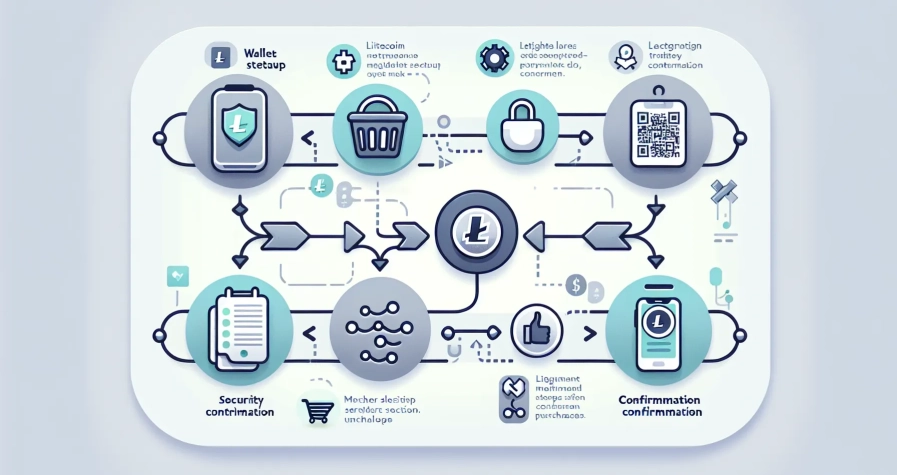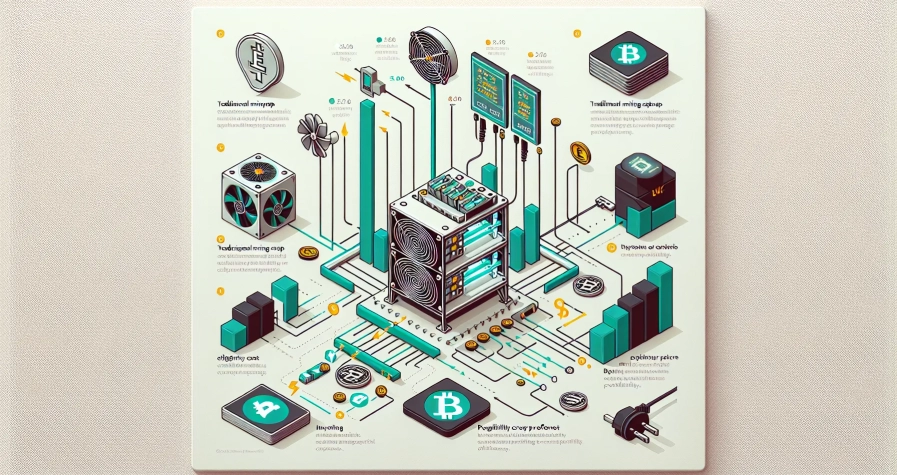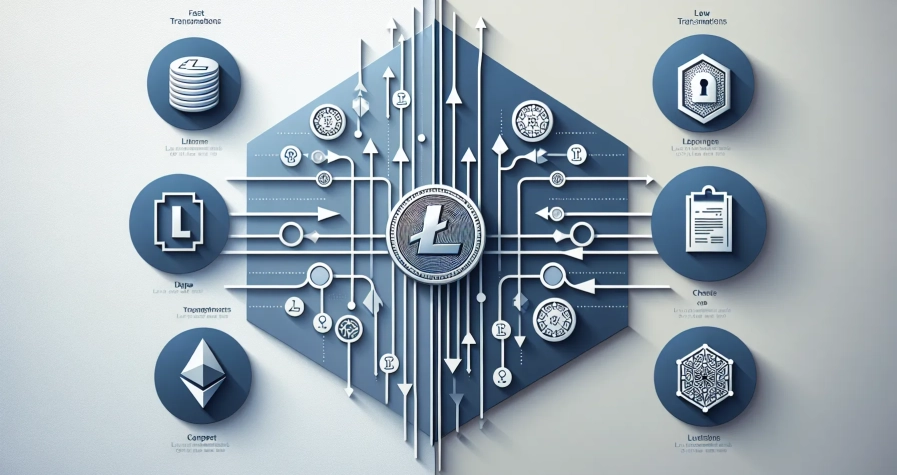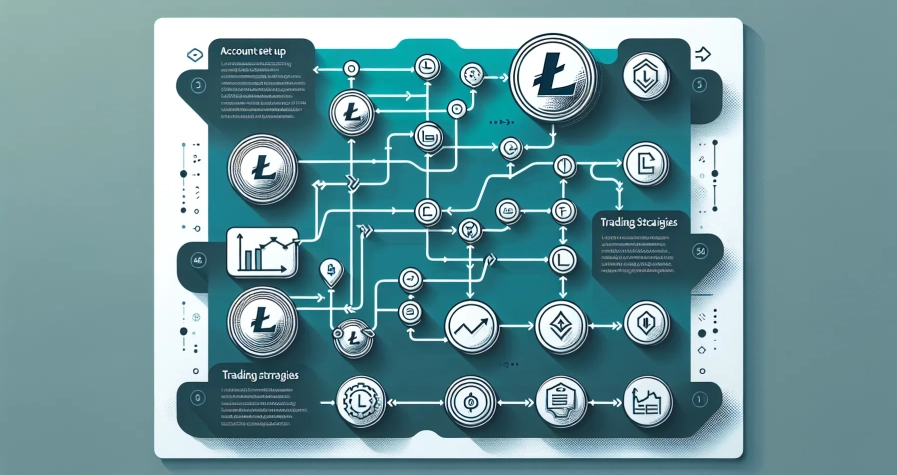When Charlie Lee launched Litecoin in October 2011, he wasn’t trying to overthrow Bitcoin. The former Google engineer had a different goal in mind: creating “digital silver” to Bitcoin’s “digital gold.” While Bitcoin would serve as a store of value for major transactions and long-term holding, Litecoin would handle everyday payments,faster, cheaper, and more accessible to the average person.
What started as a simple fork of Bitcoin’s codebase has evolved into one of the cryptocurrency world’s most enduring success stories. Litecoin didn’t just survive the brutal bear markets and countless competitors that have come and gone over the years. It carved out its own niche, became a testing ground for blockchain innovations, and earned a reputation as the reliable workhorse of digital currencies. Fourteen years later, Litecoin remains a cornerstone of the crypto ecosystem, consistently ranking among the top cryptocurrencies by market cap and exchange volume.
Key Takeaways
- Litecoin was launched in October 2011 by Charlie Lee as ‘digital silver’ to Bitcoin’s ‘digital gold,’ focusing on faster, cheaper everyday transactions rather than competing as a store of value.
- The History of Litecoin showcases key technical advantages including 2.5-minute block times (four times faster than Bitcoin), an 84 million coin supply cap, and initially ASIC-resistant Scrypt mining for broader accessibility.
- Litecoin served as a successful testing ground for major blockchain innovations like SegWit and Lightning Network, activating these upgrades before Bitcoin and proving their viability at scale.
- The cryptocurrency has maintained remarkable longevity and market stability, remaining among the top cryptocurrencies by market cap for over 14 years while thousands of altcoins have disappeared.
- MimbleWimble Extension Blocks (MWEB) added optional privacy features to Litecoin, allowing users to transact privately while maintaining transparency when needed for compliance.
- Litecoin’s widespread exchange listing and merchant adoption make it one of the most practical cryptocurrencies for real-world payments, with consistently low fees and reliable transaction speeds.
The Birth of Litecoin in 2011

Litecoin emerged during a pivotal moment in cryptocurrency history. Bitcoin had proven the concept of decentralized digital money, but early adopters were already identifying its limitations. Transaction times felt sluggish for practical daily use, and mining was becoming increasingly concentrated among those with specialized hardware. Charlie Lee saw an opportunity to create something complementary,not a competitor, but a lighter, faster alternative built on Bitcoin’s proven foundation.
Lee took Bitcoin’s open-source code and modified it with specific improvements in mind. The result was Litecoin, launched on October 7, 2011, through an open-source client released on GitHub. Unlike many cryptocurrency projects that followed, Litecoin had no pre-mine or instamine,Lee wanted a fair launch that echoed Bitcoin’s ethos of decentralization and accessibility.
Charlie Lee’s Vision for Digital Silver
Lee’s “digital silver” analogy wasn’t just clever marketing,it reflected a genuine philosophical approach to cryptocurrency adoption. If Bitcoin would be held and traded like gold, serving as a high-value store of wealth, then Litecoin could function like silver: more abundant, more practical for everyday transactions, and complementary rather than competitive.
This vision meant Litecoin didn’t need to replace Bitcoin or even directly challenge it. Instead, it could coexist in the same ecosystem, serving a different purpose. Lee believed the world had room for multiple cryptocurrencies, each optimized for specific use cases. Litecoin would be the currency you’d use to buy coffee or send money to a friend, while Bitcoin handled your retirement savings or real estate transactions.
Lee’s background as an engineer at Google gave him both the technical chops and the product design sensibility to execute on this vision. He understood that for Litecoin to succeed as a payment currency, it needed to solve real problems that Bitcoin users encountered daily: confirmation times, transaction costs, and mining accessibility.
Key Technical Differences from Bitcoin
Litecoin’s modifications to Bitcoin’s codebase weren’t radical departures,they were calculated adjustments designed to improve specific metrics. The most significant change was the block generation time. While Bitcoin produces a new block approximately every 10 minutes, Litecoin generates blocks every 2.5 minutes. This four-fold increase in speed meant transactions received their first confirmation much faster, making Litecoin more practical for point-of-sale purchases and other time-sensitive payments.
The total supply cap also differed. Bitcoin’s famous 21 million coin limit was multiplied by four, giving Litecoin a maximum supply of 84 million LTC. This wasn’t arbitrary,it maintained the same ratio as the block time difference, preserving the economic scarcity model while allowing for greater divisibility and psychological accessibility at lower price points.
Perhaps the most interesting technical distinction was Litecoin’s choice of mining algorithm. Instead of Bitcoin’s SHA-256, Lee implemented Scrypt, a memory-intensive proof-of-work algorithm. At the time, Scrypt mining was ASIC-resistant, meaning everyday people could mine Litecoin using consumer-grade hardware,standard CPUs and GPUs,rather than needing expensive specialized equipment. This democratized mining, at least initially, and aligned with Litecoin’s goal of accessibility.
These technical choices created a cryptocurrency that felt familiar to Bitcoin users but performed differently where it mattered. Faster blocks meant quicker confirmations. A larger supply meant smaller unit prices and easier mental math. An accessible mining algorithm meant broader participation in network security. Together, these differences positioned Litecoin as the practical sibling to Bitcoin’s aspirational presence.
Early Adoption and Growing Pains

Being one of the first altcoins gave Litecoin both advantages and challenges. On one hand, it faced little competition in the “Bitcoin alternative” space during its early years. On the other, it had to build everything from scratch: exchange listings, merchant adoption, community infrastructure, and market liquidity.
Litecoin quickly gained a following among cryptocurrency enthusiasts who appreciated its technical improvements and Lee’s transparent leadership. Early adopters saw it as a legitimate project with real utility, not just another speculative token. But the road wasn’t smooth. Exchange support was limited at first, creating liquidity problems that made it difficult to buy, sell, or price LTC accurately. Many merchants and payment processors were still struggling to integrate Bitcoin, let alone a second cryptocurrency.
Market volatility also tested Litecoin’s resilience. The cryptocurrency markets of 2011-2013 were wild, characterized by dramatic price swings, exchange hacks, regulatory uncertainty, and widespread skepticism from mainstream finance. Every altcoin launch brought questions about whether the space was getting too fragmented, whether any coin besides Bitcoin would survive, and whether the whole thing was just an elaborate experiment destined to fail.
Building Community and Infrastructure
What set Litecoin apart during these formative years was its community and leadership. Charlie Lee remained actively involved, engaging directly with users, developers, and skeptics. His presence on forums, social media, and at cryptocurrency conferences gave Litecoin legitimacy and continuity that many competing projects lacked.
The establishment of the Litecoin Foundation provided organizational structure for ongoing development and promotion. Unlike many early altcoins that faded when their anonymous creators moved on, Litecoin had visible leadership and institutional support. The Foundation coordinated development efforts, managed marketing initiatives, and worked to expand merchant adoption.
Exchange listings gradually increased, with major platforms recognizing Litecoin as one of the few altcoins worth supporting. Payment processors began integrating LTC alongside Bitcoin, and a growing number of online merchants started accepting it. These weren’t just vanity metrics,they represented real infrastructure that made Litecoin more usable and more valuable to hold.
The Litecoin community itself became one of the project’s strongest assets. Unlike some cryptocurrency communities that prioritized hype and speculation, Litecoin’s followers tended to focus on utility, stability, and long-term viability. This created a positive feedback loop: a mature community attracted serious developers, which led to better technology, which attracted more users and merchants.
Surviving the 2013-2014 Crypto Winter
Bitcoin’s price crash from its late-2013 high of over $1,000 down to the $200s by early 2015 created one of cryptocurrency’s first major bear markets. This “crypto winter” was brutal for altcoins, many of which lost 90% or more of their value and never recovered. Projects were abandoned, exchanges closed, and mainstream interest evaporated.
Litecoin weathered this storm better than most. While its price certainly declined along with the broader market, the project never stalled. Development continued, the community remained active, and exchange support held steady. Lee’s ongoing involvement was crucial,he didn’t disappear during the downturn like so many other cryptocurrency founders.
This resilience established Litecoin’s reputation as a survivor. When new investors entered the space during subsequent bull runs, they found that Litecoin was still there, still functional, and still improving. That staying power became part of its brand identity. If you wanted to diversify beyond Bitcoin but didn’t want to gamble on unproven projects, Litecoin was the safe choice. It had survived the winter.
Major Milestones and Technological Innovations
Litecoin’s longevity isn’t just about surviving,it’s about evolving. Over the years, the project has consistently adopted cutting-edge blockchain technologies, often serving as a proving ground for upgrades that would later come to Bitcoin.
This willingness to innovate while maintaining stability has been central to Litecoin’s continued relevance. The project hasn’t rested on its “digital silver” laurels but has actively pushed the boundaries of what a UTXO-based blockchain can do.
SegWit Activation and Lightning Network Integration
In May 2017, Litecoin made history by activating Segregated Witness (SegWit) on its mainnet,and it did so before Bitcoin. SegWit was a significant protocol upgrade designed to fix transaction malleability issues and increase the effective block capacity by changing how transaction data was stored. It was controversial in Bitcoin circles, with fierce debates about block size and the future of the network.
Litecoin’s successful SegWit activation proved the upgrade worked at scale, providing real-world data that helped inform Bitcoin’s own SegWit implementation later that year. This wasn’t just technical housekeeping,it was Litecoin living up to its role as Bitcoin’s testnet, taking calculated risks so Bitcoin could proceed more confidently.
SegWit also enabled second-layer solutions like the Lightning Network, which Litecoin quickly embraced. Lightning allows for near-instant, extremely low-fee transactions by creating payment channels off the main blockchain. For Litecoin’s vision of everyday payments, Lightning was a perfect fit. Users could now send tiny amounts of LTC across borders in seconds, with fees measured in fractions of a cent.
The integration of Lightning Network technology transformed Litecoin from merely “fast” to genuinely instant for many use cases. It also enabled cross-chain atomic swaps between LTC and BTC, allowing users to exchange the two currencies directly without an intermediary,another proof-of-concept that demonstrated blockchain interoperability.
MimbleWimble and Privacy Enhancements
As cryptocurrency adoption grew, so did concerns about transaction privacy. Bitcoin and Litecoin transactions are pseudonymous rather than anonymous,all transactions are visible on the public blockchain, and with enough effort, they can often be traced back to real-world identities. For a currency designed for everyday use, this raised legitimate privacy concerns.
Litecoin’s response was the MimbleWimble Extension Blocks (MWEB) upgrade, which introduced optional privacy features. MimbleWimble is a blockchain protocol design focused on privacy and scalability, originally proposed anonymously in 2016. By implementing it as extension blocks, Litecoin users could opt into enhanced privacy without forcing it on the entire network or compromising the transparency that some use cases require.
MWEB transactions hide amounts and obscure the transaction graph, making it far more difficult to trace fund flows. Users can move LTC into the MWEB, transact privately, and then move back to the regular blockchain when transparency is needed. This elegant solution balanced privacy advocates’ concerns with regulatory considerations and gave users genuine choice.
Once again, Litecoin was pushing boundaries. While privacy-focused cryptocurrencies like Monero and Zcash existed, integrating strong privacy features into an established, widely-adopted blockchain was a different challenge. Litecoin’s approach demonstrated that privacy and compliance-friendly transparency could coexist in the same system.
Market Performance and Exchange Adoption
Market performance and infrastructure support are two sides of the same coin in cryptocurrency. Litecoin has excelled at both, maintaining its position among the top cryptocurrencies by market capitalization for over a decade,a rare feat in such a volatile, competitive industry.
Litecoin is listed on virtually every major cryptocurrency exchange worldwide, from Coinbase and Kraken to Binance and international platforms across Asia, Europe, and Latin America. This ubiquitous availability creates deep liquidity, making it easy to buy, sell, or trade LTC without significant slippage. For traders, liquidity matters. For everyday users, it means you can reliably convert LTC to local currency or other cryptocurrencies whenever needed.
Payment processor adoption has been equally impressive. Major crypto payment gateways like BitPay, Coinbase Commerce, and CoinPayments have supported Litecoin for years, enabling thousands of online and brick-and-mortar merchants to accept LTC alongside Bitcoin and other cryptocurrencies. This isn’t just theoretical acceptance,real businesses use Litecoin for real transactions every day.
The consistency of Litecoin’s market presence is perhaps its most underrated achievement. While countless cryptocurrencies have experienced dramatic boom-and-bust cycles or faded into obscurity, Litecoin has remained remarkably stable in its market position. It’s weathered multiple bear markets, competition from thousands of newer altcoins with flashier features, and regulatory uncertainty across different jurisdictions.
This stability breeds trust. Institutional investors and retail users alike value predictability. Litecoin’s track record suggests it will be around tomorrow, next year, and a decade from now,something that can’t be said for the vast majority of cryptocurrency projects. That reliability has translated into sustained exchange support, continued merchant adoption, and a persistent user base that sees Litecoin as a safe harbour in the chaotic crypto seas.
Litecoin’s Role in the Modern Crypto Ecosystem
As the cryptocurrency landscape has matured, Litecoin’s role has evolved from “Bitcoin alternative” to “Bitcoin complement” and testing ground for blockchain innovation. Its position in the modern crypto ecosystem is multifaceted, reflecting both its original design goals and its continued adaptability.
Litecoin serves as a medium-ground cryptocurrency,established enough to be trusted, fast enough for practical use, and liquid enough for serious trading. While Bitcoin has increasingly become a store of value and institutional asset, and while newer blockchains like Ethereum have focused on smart contracts and DeFi, Litecoin has stayed true to its original purpose: being a reliable, efficient payment network.
Payment Processing and Merchant Acceptance
In the real world of commerce, Litecoin has carved out a meaningful niche. Its combination of speed, low fees, and widespread acceptance makes it practical for actual purchases in a way that Bitcoin’s higher fees and slower confirmations sometimes aren’t.
Online retailers, gaming platforms, VPN services, and even some physical stores accept Litecoin. The LTC payment flow is straightforward: transactions confirm quickly enough for point-of-sale scenarios, fees are predictable and minimal (typically fractions of a cent), and the infrastructure for accepting LTC is mature and well-documented.
Payment processing isn’t just about technology,it’s about trust and brand recognition. Merchants are more likely to integrate a cryptocurrency they’ve heard of, that’s been around for years, and that their customers already own. Litecoin checks all those boxes. While it may not generate the same headlines as newer DeFi tokens or NFT platforms, it quietly facilitates thousands of real economic transactions.
For users in countries with unstable currencies or limited banking infrastructure, Litecoin offers a stable, accessible alternative. Its lower price per coin compared to Bitcoin makes it psychologically easier to spend, and its established exchange presence means it can be reliably converted to local currencies when needed.
Testing Ground for Bitcoin Upgrades
Perhaps Litecoin’s most important modern role is as Bitcoin’s testbed. Because Litecoin and Bitcoin share similar codebases and UTXO architecture, technologies developed for one can often be adapted for the other. But Bitcoin’s conservative approach to upgrades,driven by its role as a trillion-dollar store of value,means that experimental features need proving grounds.
That’s where Litecoin comes in. SegWit, Lightning Network integrations, atomic swaps, and other technologies have been tested on Litecoin’s mainnet before being adopted by Bitcoin. This benefits both ecosystems: Litecoin gets cutting-edge features and the prestige of being first, while Bitcoin gets battle-tested technology with real-world data on performance and security.
This symbiotic relationship reinforces Litecoin’s “digital silver” identity. Silver has historically been used to test metallurgical processes before applying them to gold. Litecoin serves a similar function in the blockchain world,valuable in its own right, but also enabling its more prestigious sibling to advance more safely.
Charlie Lee has encouraged this role, actively supporting cross-project collaboration and knowledge sharing. Rather than viewing Litecoin and Bitcoin as competitors, he sees them as complementary parts of a broader cryptocurrency ecosystem. This collaborative mindset has earned respect from Bitcoin developers and contributed to Litecoin’s long-term sustainability.
Conclusion
Fourteen years after its launch, Litecoin stands as one of cryptocurrency’s most remarkable success stories,not because it revolutionized the technology or created entirely new use cases, but because it identified a specific need and has consistently delivered on that promise.
Charlie Lee’s vision of “digital silver” has proven prescient. The cryptocurrency ecosystem does have room for multiple players with different strengths, and Litecoin’s combination of speed, reliability, and accessibility has kept it relevant through wave after wave of new competition. While thousands of altcoins have come and gone, Litecoin remains a staple,listed on every major exchange, accepted by thousands of merchants, and held by millions of users worldwide.
The project’s willingness to innovate while maintaining stability is a delicate balance that few cryptocurrency projects have managed to achieve. By adopting SegWit before Bitcoin, integrating Lightning Network, and implementing privacy features through MWEB, Litecoin has stayed technologically current. Yet it has done so without sacrificing the conservative, reliability-focused approach that made it trustworthy in the first place.
Looking ahead, Litecoin’s role as a payment-focused blockchain and Bitcoin testnet seems secure. As long as Charlie Lee and the Litecoin Foundation continue their transparent leadership, as long as the network maintains its technical advantages, and as long as the community values utility over hype, Litecoin will likely remain a cornerstone of the cryptocurrency landscape.
In an industry obsessed with the next big thing, Litecoin’s greatest achievement might be its consistency. It’s still here, still working, still improving,exactly what you’d want from digital silver.
Frequently Asked Questions
What is Litecoin and why was it created?
Litecoin is a cryptocurrency launched by Charlie Lee in October 2011 as ‘digital silver’ to Bitcoin’s ‘digital gold.’ It was designed to handle everyday payments with faster transaction times, lower fees, and greater accessibility for regular users.
How is Litecoin different from Bitcoin technically?
Litecoin generates blocks every 2.5 minutes compared to Bitcoin’s 10 minutes, has a maximum supply of 84 million coins versus 21 million, and originally used the Scrypt mining algorithm to enable mining with consumer-grade hardware.
What major technological innovations has Litecoin introduced?
Litecoin activated SegWit before Bitcoin in May 2017, integrated Lightning Network for near-instant transactions, and implemented MimbleWimble Extension Blocks for optional privacy features, often serving as a testing ground for Bitcoin upgrades.
Can I use Litecoin for everyday purchases?
Yes, Litecoin is accepted by thousands of merchants worldwide through major payment processors like BitPay and Coinbase Commerce. Its fast confirmation times and low fees make it practical for point-of-sale transactions and online purchases.
Is Litecoin still relevant in today’s cryptocurrency market?
Absolutely. Litecoin has maintained its position among top cryptocurrencies for over 14 years, is listed on every major exchange, and continues to evolve while serving as a reliable payment network and testing ground for blockchain innovations.
How does Litecoin’s transaction speed compare to other cryptocurrencies?
Litecoin’s 2.5-minute block time makes it four times faster than Bitcoin for first confirmations. With Lightning Network integration, transactions become near-instant with fees measured in fractions of a cent, competing favorably with most payment-focused cryptocurrencies.









